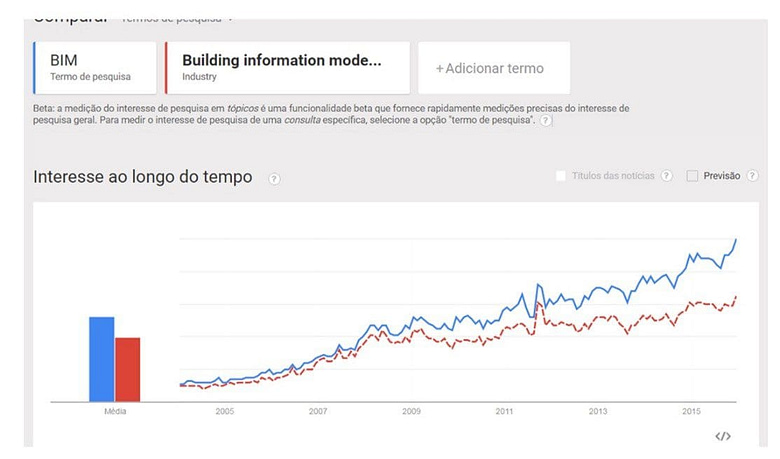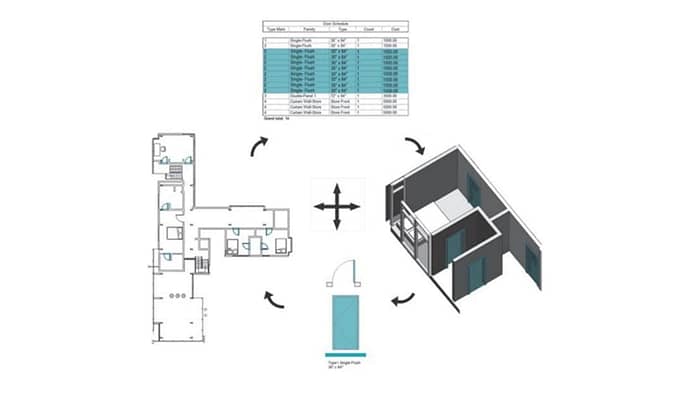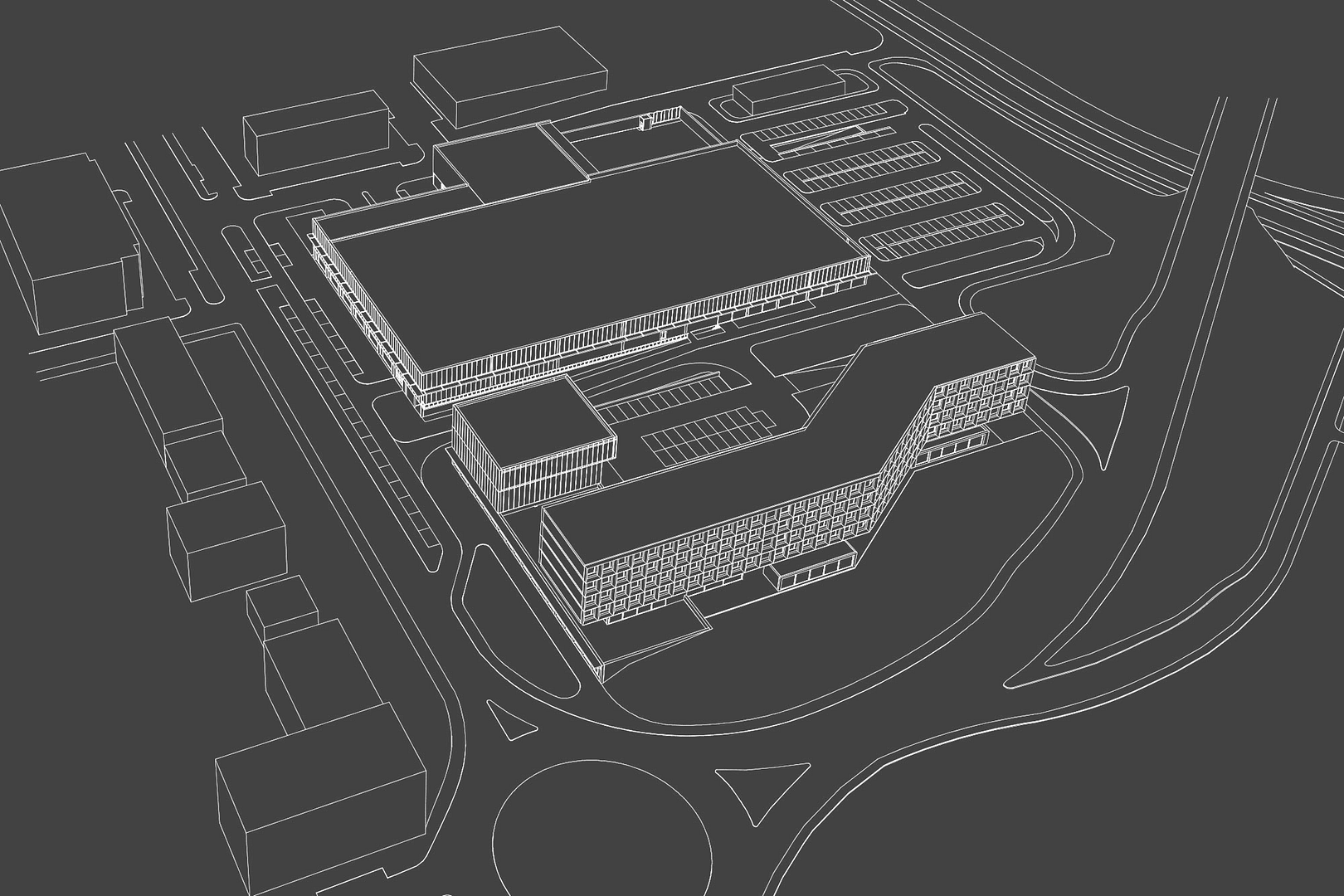BIM and its benefits
In mid-2003, the BIM methodology, an acronym for Building Information Modeling, appeared to respond to the challenging global representation of buildings, the weak communication and cooperation existing between professionals in the sector, the integration of different projects and the management of all information generated during the construction process. Presenting various advantages in each phase of the project and for each of the different players, BIM has gained increasing popularity and appreciation in the sector. This interest has increased exponentially in recent years globally, verifiable by a simple search for the word “BIM” in the main Internet search engines. Google presents 50 million results, Bing 13 million results, or even YouTube with 1 million videos available and even LinkedIn where 272 thousand results appear with BIM in the “keyword”. Image 1 shows the worldwide interest in the term BIM since 2004.

Capable of being translated as a broad and intelligent data repository, BIM uses a three-dimensional model of the project as the centerpiece of the entire process, which is gradually enriched and taking shape as the Project develops. As a result, a faithful and accurate three-dimensional digital representation of the building will be made available, with all its physical and functional characteristics. This central piece is created using BIM modeling programs, where part of the information entered is associated with other databases that will be integrated with this 3D model. This model appears as an integrated database that will cover a vast amount of information related to the project, from materials used and their quantities, area volumes, supplier contacts, installation dates and costs.
BIM is a powerful methodology that simplifies the process of collecting, storing and communicating information on a Project as it is a single source of work between all stakeholders for all types of data, phases and specialties. BIM is information and the result of its adoption involves the acquisition of a shared knowledge base that will support decision-making throughout the lifecycle of the project, allowing cost reduction, elimination of waste and improved communication. among all actors in the value chain. This new work methodology promotes a change in the energy given to the overall process, where greater focus is given to the initial phase of the Project and the problems that may arise in the construction phase are anticipated. At the same time, BIM tries to eliminate weak data organization and management, avoiding the introduction of errors, omissions and uncoordinated information; characteristics of more traditional processes.
Despite being often mistakenly associated, BIM strongly distinguishes itself from CAD tools as it provides a complete integrated database in which one of its fundamental characteristics is the collection of parameterized objects that contain essential information for the construction process. It is thanks to the parametric relationships created between objects, allowing them to have characteristics or parameters that define conformity between them, that all the information entered is interconnected, leading to a real-time update of all changes made. This means that if we modify any aspect of one of these objects, all the others will be updated, avoiding the propagation of errors and poor coordination of information. All the information created is consistent across the different visualization methods (tables or graphs) and any modification made at any stage will be reproduced in all of them, as shown in image 2. In this way, one of the weaknesses of CAD is overcome – when , for example, a door underwent a design review, as a result, it would be necessary for all drawings to be reviewed and updated, as well as all tables of quantities.

.
In CAD technology, projects are “stripped” of information and relationships between objects, and it is in this aspect that BIM stands out the most because it is possible to relate data fields between sets of objects contained in the model. A varied set of functionalities is promoted, such as extracting quantities, budgeting, work planning, space and equipment management, energy analysis, among many others. This new working method also facilitates the creation of new objects with customizable parameters for the Project in progress, that is, BIM can be “programmable” and promotes a considerable improvement in the sharing of information that was difficult with CAD tools. All the benefits that BIM presents are possible due to the incorporation of the concept of parametric modeling and through the interoperability supported by standardized open files.
Working with the BIM methodology is working in a more collaborative way. It is a new working method that offers numerous advantages and is seen as a potential solution to restore the construction sector to a more competitive level. It is necessary to emphasize that BIM should be seen as a process that allows better management of all constructive information, in a collaborative work environment and should not be associated with an acquired technical capacity. The BIM model is being molded and developed as it is shared by different professionals, throughout the different phases, gaining ever greater value and quality. For this reason, the model does not have a unique application and will not always bring the same benefits. Being a new working method, it will only be stimulated and implemented when its benefits become significant and stimulating for users.
To better interpret all the advantages that BIM offers to the sector, it will be more interesting to study them from the point of view of the main participants in the Project, detailing the advantages pointed out by the DO, Project manager, architect, engineers, contractors, subcontractors, manufacturers.
Work Owner
The Work Owner (DO), when he starts his Project, will only demand something if that choice really presents some value. You will then have to recognize that, by adopting BIM, you will increase your profit margins, reduce unforeseen costs and promote better coordination between the design team and the construction company. As the three-dimensional model of the project is enriched, the DO monitors this development and values this interactivity – he can better visualize and understand his Project, take advantage of the appealing virtual representation created and use it for marketing purposes. In the preliminary program, BIM can be used to extrapolate volumes and areas of spaces and floors created, both graphically and in tables, to confirm that the requirements demanded by the Owner of Work are being fulfilled. BIM will also offer the client powerful tools to help them achieve their sustainability goals in the construction project, from the design phase, through construction to operation and maintenance. Project Owners often face budget overruns, and contingency estimates are often prepared to mitigate them and which are translated into conservative budgets to sustain…

